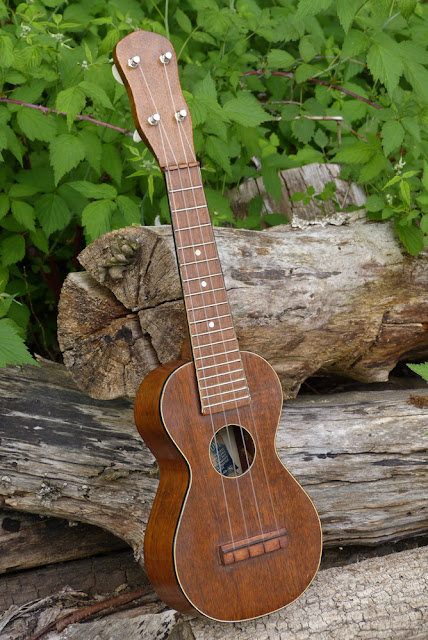1920s Harmony-made Supertone Fancy Mahogany Soprano Ukulele
I'm sure someone with the right Sears catalog can read off the model number, but this is a Harmony-made product for the Supertone brand sold by said giant mailorder house. I've worked on a few different variations of this uke, but it's basically an upscaled version of Harmony's basic all-mahogany soprano uke from the early 20s. The chief upgrade is two-ply celluloid binding at the soundhole and top edge and an "actual" bound fretboard with an extension that adds an additional 5 frets. Otherwise, the sound, bracing, and build is more-or-less identical to Harmony's simpler models.
Work on this included a neck reset (glued/bolted -- more on that in a bit), fret level/dress, new ebony saddle, and one cleat/repair to a small, tight hairline crack on the back (the only crack on it). This uke plays "as it should" with 1/16" action at the 12th fret and it has a friendly, nicely-loud, full voice (for its size).
Work on this included a neck reset (glued/bolted -- more on that in a bit), fret level/dress, new ebony saddle, and one cleat/repair to a small, tight hairline crack on the back (the only crack on it). This uke plays "as it should" with 1/16" action at the 12th fret and it has a friendly, nicely-loud, full voice (for its size).
The "peanut" body shape recalls Hawaiian-made ukes of the time... which is what Harmony was attempting to emulate. This uke is entirely made from solid mahogany.
The only "new" bit on the uke are some nicer, Saga-style friction pegs. They work just dandy.
This has a 1 3/8" nut width and a C-shaped neck profile.
Pearl dots as markers and original nickel-silver frets are in the board. I've strung the uke with fluorocarbon strings.
After the neck set, the saddle was just a tiny, tiny-bit too low. I cut it off, cut a new slot, and installed an ebony saddle in its place -- which gives the bridge more of that "Martin" look, anyhow, and serves as an upgrade.
The tiny hairline crack on the back is actually in the "lower left" portion of this picture -- but as you can see, it's impossible to get a photo of it. I cleated it on the inside just in case, but it wasn't moving at all, anyhow.
If you look at the back of the heel you'll see a tiny circular area that's just slightly discolored from the rest. That's where I filled a pilot hole to install the "neck bolt" through the soundhole. These neck joints are actually dovetail-wannabe tenon joints and they always come loose as they only run halfway down the body. I reglue them and add a neck bolt for stability's sake. I simply don't want owners of this instrument for its next 100 years of life to have to fuss with that joint when/if the glue wants to creep somewhere down the line.
The mahogany is plain-but-pretty on this uke.


















Comments